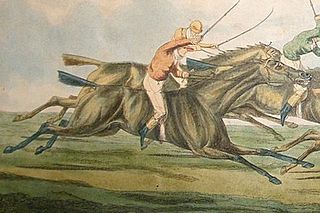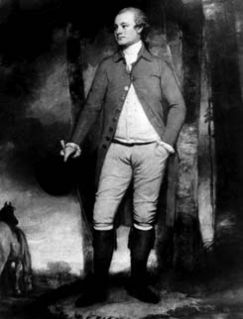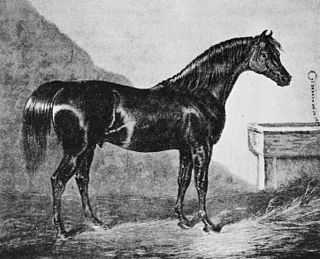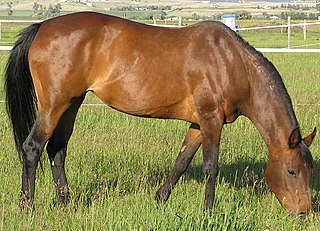Azor was a British Thoroughbred racehorse. In a career that lasted from April to October 1817 he ran five times and won two races. In the summer of 1817 he created a 50/1 upset by winning The Derby after being entered in the race to act as a pacemaker for a more highly regarded stable companion. The rest of his form was well below top class, with his only other success coming when he was allowed to walk over at Newmarket.

Sam was a British Thoroughbred racehorse and sire. In a career that lasted from April 1818 to May 1819 he ran nine times and won three races. In May 1818 he defeated fifteen opponents to record his most important win in The Derby. His only other wins came in a walkover and a match race. After running without success as a four-year-old, Sam was retired to stud but made no impact as a sire of winners.
Corinne was a British Thoroughbred racehorse and broodmare, which in 1818 became the second filly to win both the 1000 Guineas at Newmarket Racecourse and the Oaks at Epsom Downs Racecourse. In a racing career which lasted from April 1818 until August 1820 she ran eighteen times and won eight races.
Bronze was a British Thoroughbred racehorse and broodmare who won the classic Oaks Stakes at Epsom Downs Racecourse in 1806. Bronze's classic win left her unbeaten in three starts, but her subsequent racing career was undistinguished: in eighteen more races she recorded only three wins, two of which were at relatively minor tracks. After being retired to stud in 1809 she proved to be a highly successful and influential broodmare, whose direct descendants have won many important races up to the present day.
Selim was a British Thoroughbred racehorse. He was owned by the Prince of Wales, D. Radcliffe and later Arthur Shakespear. After retiring from racing he became a successful stallion and was British Champion sire in 1814. His progeny included Azor, Medora, Sultan and Turquoise.

Prunella was a British Thoroughbred racehorse. Raced from 1791 to 1794, she won three races including a Sweepstakes of 200 guineas each at Newmarket. She was retired to stud and became an influential broodmare, foaling Epsom Derby winner Pope and Epsom Oaks winner Pelisse. Her daughters also went on to become top broodmares in their own right. She was owned by Augustus FitzRoy, 3rd Duke of Grafton.
Rubens was a British Thoroughbred racehorse. During his career he won three races, including the Craven Stakes in 1810. After retiring from racing he became a successful stallion and was the leading sire in Great Britain and Ireland in 1815, 1821 and 1822. His progeny included Landscape, Pastille, Whizgig and the Rubens mare.
The Rubens mare was an unnamed British Thoroughbred racehorse. In her only race she finished second in The Oaks in 1822. Later she became a top broodmare, foaling Ascot Gold Cup winner Camarine, 1000 Guineas winners May-day and Firebrand and Epsom Derby winner Phosphorus.

Nike was a British Thoroughbred racehorse. She won three of her five starts, including the Oaks Stakes in 1797. She was owned Richard Grosvenor, 1st Earl Grosvenor, and later became a broodmare, with three of her foals placing in Classic races.

Pope Joan was a British Thoroughbred racehorse. She won four of her eight starts before being retired to stud, where she became a successful broodmare. She foaled 1000 Guineas winner Tontine, 2000 Guineas winner Turcoman and Epsom Oaks winner Turquoise. Pope Joan was bred by Augustus FitzRoy, 3rd Duke of Grafton and after his death was owned by his son George FitzRoy, 4th Duke of Grafton.

Penelope (1798–1824) was a British Thoroughbred racehorse. She won sixteen of her twenty-four races, including two Oatlands Stakes, the Jockey-Club Plate and she beat Oaks and Derby winner Eleanor. She was bred and owned by Augustus FitzRoy, 3rd Duke of Grafton. After retiring from racing she became an influential broodmare, foaling Derby winners Whalebone and Whisker and 1000 Guineas winner Whizgig.
Camel was a British Thoroughbred racehorse. He won five of his seven races, including the Port Stakes in 1825, but his appearances were limited by leg problems. Throughout his racing career he was owned by Charles Wyndham. After retiring from racing Camel became a successful stallion, siring St. Leger winners Touchstone and Launcelot and becoming British Champion sire in 1838.
Sorcerer (1796–1821) was a British Thoroughbred racehorse. He ran mainly at Newmarket and won fifteen of his twenty-one races, including the October Oatlands Stakes in 1800. After retiring from racing he became a successful stallion and was the leading sire in Great Britain and Ireland for three years. Amongst his progeny were Morel, Maid of Orleans, Wizard, Soothsayer, Sorcery, Trophonius, Comus and Smolensko. He was bred and owned by Sir Charles Bunbury and died in 1821.

Young Giantess (1790–1811) was a British Thoroughbred racehorse and broodmare. She failed to win any of the five races she contested, but became a successful broodmare for Sir Charles Bunbury. She foaled the successful sire Sorcerer and Derby and Oaks winner Eleanor.

Parasol (1800–1826) was a British Thoroughbred racehorse. In total she won twenty of her thirty-five races, including two Newmarket First October King's Plates, the Jockey-Club Plate and a match race against Derby winner Cardinal Beaufort. Her only race away from Newmarket was for her début, in the Oaks Stakes in 1803. She was bred and owned by Augustus FitzRoy, 3rd Duke of Grafton. As a broodmare she foaled the stallion Partisan, 2000 Guineas winner Pindarrie and Pastille, who won both the 2000 Guineas and the Oaks.

Pindarrie was a British Thoroughbred racehorse. He raced five times and won the Riddlesworth Stakes and 2000 Guineas Stakes. He was owned by George FitzRoy, 4th Duke of Grafton, and trained by Robert Robson. He only raced in 1820 and was then sent to India.
Tag was a British Thoroughbred racehorse. She only started three races, and won once, the Oaks Stakes at Epsom Downs. She was owned by George Wyndham, 3rd Earl of Egremont, and trained by Frank Neale. As a broodmare for the Earl she produced eleven foals.

Bridget (1776–1798) was a British Thoroughbred racehorse who won the inaugural running of the Oaks Stakes in 1779. She was bred and owned by Edward Smith-Stanley, 12th Earl of Derby, for whom she produced five foals as a broodmare.

Walton was a British Thoroughbred racehorse. He raced until he was eight years old, winning sixteen of his twenty five races. His first race was in 1802, with his first big win, the Third Class of the Oatlands Stakes, coming in 1803. He went on to win eight King's Plates and recorded wins over several leading racehorses of the time. He was owned by Sir Hedworth Williamson throughout his racing career. Walton later became a successful stallion and was champion sire of Great Britain twice. He sired the Derby winner Phantom, 2000 Guineas winner Nectar and St. Leger winner St Patrick.
Imperatrix was a British Thoroughbred racehorse. She raced only twice, with her only win coming in the 1782 St. Leger Stakes. She was bred and owned by John Pratt. As a broodmare, Imperatrix produced nine foals.

















